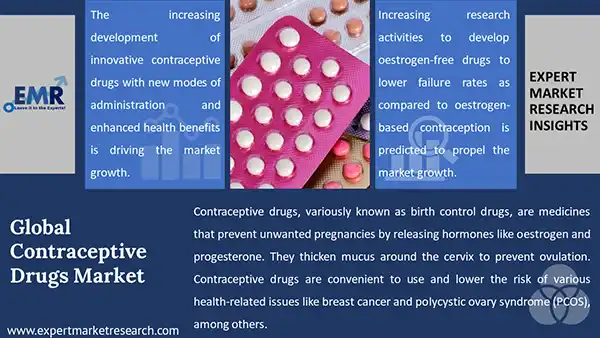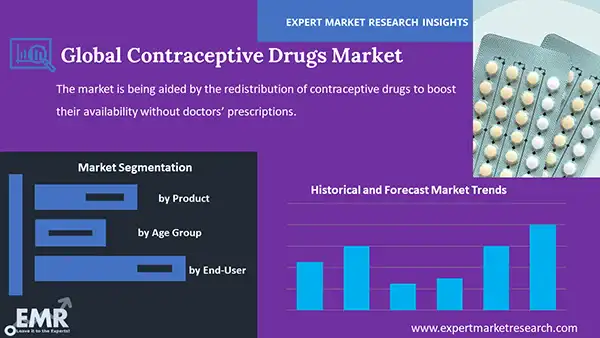
Consumer Insights
Uncover trends and behaviors shaping consumer choices today
Procurement Insights
Optimize your sourcing strategy with key market data
Industry Stats
Stay ahead with the latest trends and market analysis.
The global contraceptive drugs market size attained a value of USD 19.94 Billion in 2025. The market is further expected to grow at a CAGR of 7.00% during the forecast period of 2026-2035 to attain a value of USD 39.22 Billion by 2035. The growth of the market is driven by the increasing awareness and acceptance of contraceptive drugs.
Base Year
Historical Period
Forecast Period
Compound Annual Growth Rate
7%
Value in USD Billion
2026-2035
*this image is indicative*
As governments are increasingly attempting to enhance the quality of life of their citizens, they are increasingly providing free and subsidised contraceptive drugs, thereby driving the growth of the market. Moreover, governments of low-and-middle-income companies are launching various favourable initiatives like advertisements to promote contraceptive drugs among their population.
For instance, in July 2019, the Health Ministry of India released about three commercials to promote oral contraceptives. In addition, various governments are selling contraceptive pills at pharmacy stores without doctor’s prescriptions, which is significantly contributing to the growth of the market.

Read more about this report - REQUEST FREE SAMPLE COPY IN PDF
The initiation of various family planning programmes and media campaigns to increase awareness regarding the importance and benefits of contraceptive drugs is augmenting the market growth. The redistribution of contraceptive services among health workers and pharmacy staff, among others, is increasing the accessibility of the underserved population of injectables and oral contractions. Hence, the increasing availability of diverse contraceptive drugs in developing countries is aiding the market growth. The development of new contraceptive technologies to boost the functionality and efficiency of contraceptive drugs is providing further impetus to the growth of the market.

Read more about this report - REQUEST FREE SAMPLE COPY IN PDF
“Contraceptive Drugs Market Report and Forecast 2026-2035” offers a detailed analysis of the market based on the following segments:
Market Breakup by Product Type
Market Breakup by Route of Administration
Market Breakup by Therapy Type
Market Breakup by Age Group
Market Breakup by Distribution Channel
Market Breakup by Region
The development of innovative contraceptive drugs to minimise the side-effects like nausea and vomiting is propelling the market growth. With the increasing attempts to boost the benefits of contraceptive drugs, new modes for their administration to enhance patient experience is surging, which is aiding the market growth. Furthermore, the increasing research activities to develop advanced contraceptive drugs is expected to propel the market growth. The rising acceptance of innovative contraceptive drugs like once-a-month pills to prevent ovulation or implantation is significantly contributing to the growth of the industry.
The increasing focus to provide innovative solutions for shared reproductive burden among both males and females is anticipated to drive the growth of the market. This is also leading to the initiation of various clinical trials of contraceptive drugs that stop sperm production to prevent unplanned pregnancies. As conventional contraceptive drugs result in side effects like nausea, vomiting, and mood swings, among others, long-acting reversible contraceptives are being developed, which is anticipated to bolster the industry growth. Moreover, increasing research activities to develop oestrogen-free drugs to lower failure rates as compared to oestrogen-based contraception is predicted to propel the market growth.
The report presents a detailed analysis of the following key players in the global contraceptive drugs market, looking into their capacity, market shares, and latest developments like capacity expansions, plant turnarounds, and mergers and acquisitions:
The comprehensive report looks into the macro and micro aspects of the industry. The EMR report gives an in-depth insight into the market by providing a SWOT analysis as well as an analysis of Porter’s Five Forces model.




*While we strive to always give you current and accurate information, the numbers depicted on the website are indicative and may differ from the actual numbers in the main report. At Expert Market Research, we aim to bring you the latest insights and trends in the market. Using our analyses and forecasts, stakeholders can understand the market dynamics, navigate challenges, and capitalize on opportunities to make data-driven strategic decisions.*
Get in touch with us for a customized solution tailored to your unique requirements and save upto 35%!
In 2025, the global contraceptive drugs market attained a value of nearly USD 19.94 Billion.
The market is projected to grow at a CAGR of 7.00% between 2026 and 2035.
The market is estimated to witness a healthy growth in the forecast period of 2026-2035 to reach about USD 39.22 Billion by 2035.
The market is being aided by the increasing availability of free and subsidised contraceptive drugs, the initiation of various family planning programmes and media campaigns, and the development of new contraceptive technologies.
The industry is expected to be augmented by the development of advanced contraceptive drugs, the rising acceptance of innovative contraceptive drugs, and the increasing clinical trials of contraceptive drugs for men.
The major regions in the industry are North America, Latin America, the Middle East and Africa, Europe, and the Asia Pacific.
The major products of contraceptive drugs in the industry are topical contraceptives, oral contraceptive pills, and injectable contraceptives.
The significant age groups in the market are 15-24 years, 25-34 years, 35-44 years, and above 44 years.
The various end-users of contraceptive drugs are homecare, hospitals, and clinics.
The major players in the industry are Allergan plc, Johnson & Johnson, Bayer AG, Piramal Healthcare, Pfizer Inc., Teva Pharmaceutical Industries Ltd., and Novartis AG, among others.
Explore our key highlights of the report and gain a concise overview of key findings, trends, and actionable insights that will empower your strategic decisions.
| REPORT FEATURES | DETAILS |
| Base Year | 2025 |
| Historical Period | 2019-2025 |
| Forecast Period | 2026-2035 |
| Scope of the Report |
Historical and Forecast Trends, Industry Drivers and Constraints, Historical and Forecast Market Analysis by Segment:
|
| Breakup by Product Type |
|
| Breakup by Route of Administration |
|
| Breakup by Therapy Type |
|
| Breakup by Age Group |
|
| Breakup by Distribution Channel |
|
| Breakup by Region |
|
| Market Dynamics |
|
| Supplier Landscape |
|
| Companies Covered |
|
Datasheet
One User
USD 3,299
USD 2,969
tax inclusive*
Single User License
One User
USD 5,499
USD 4,949
tax inclusive*
Five User License
Five User
USD 6,999
USD 5,949
tax inclusive*
Corporate License
Unlimited Users
USD 8,199
USD 6,969
tax inclusive*
*Please note that the prices mentioned below are starting prices for each bundle type. Kindly contact our team for further details.*
Flash Bundle
Small Business Bundle
Growth Bundle
Enterprise Bundle
*Please note that the prices mentioned below are starting prices for each bundle type. Kindly contact our team for further details.*
Flash Bundle
Number of Reports: 3
20%
tax inclusive*
Small Business Bundle
Number of Reports: 5
25%
tax inclusive*
Growth Bundle
Number of Reports: 8
30%
tax inclusive*
Enterprise Bundle
Number of Reports: 10
35%
tax inclusive*
How To Order

Select License Type
Choose the right license for your needs and access rights.

Click on ‘Buy Now’
Add the report to your cart with one click and proceed to register.

Select Mode of Payment
Choose a payment option for a secure checkout. You will be redirected accordingly.
Gain insights to stay ahead and seize opportunities.

Get insights & trends for a competitive edge.

Track prices with detailed trend reports.

Analyse trade data for supply chain insights.

Leverage cost reports for smart savings

Enhance supply chain with partnerships.

Connect For More Information
Our expert team of analysts will offer full support and resolve any queries regarding the report, before and after the purchase.
Our expert team of analysts will offer full support and resolve any queries regarding the report, before and after the purchase.
We employ meticulous research methods, blending advanced analytics and expert insights to deliver accurate, actionable industry intelligence, staying ahead of competitors.
Our skilled analysts offer unparalleled competitive advantage with detailed insights on current and emerging markets, ensuring your strategic edge.
We offer an in-depth yet simplified presentation of industry insights and analysis to meet your specific requirements effectively.
Share